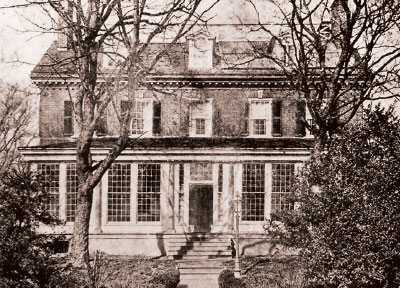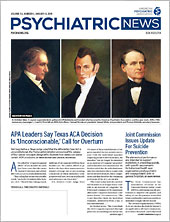On October 16, 1844, 13 doctors gathered in the Jones Hotel on Chestnut Street in Philadelphia. Each was in charge of patient care at 13 of the 31 psychiatric hospitals, or asylums, in the United States. After four days of deliberation, they agreed to form the Association of Medical Superintendents of American Institutions for the Insane, a modest beginning to what would eventually become the American Psychiatric Association.
They elected Samuel Woodward of the Worcester State Lunatic Hospital in Massachusetts as president. Samuel White, who ran a private asylum in Hudson, N.Y., was named vice president, and Thomas Kirkbride of the Philadelphia Hospital for the Insane became secretary and treasurer. The nascent association was the first national medical society in the United States. The American Medical Association would be founded in 1847.
Hospital care for those with mental disorders was still an innovation, and the members sought to “assist each other in improving the treatment of the insane” by sharing their knowledge and experience in caring for people with mental illness.
Perceptions of mental illness and what to do about it had changed steadily during the previous two centuries. Chaining mentally ill people in jails and almshouses began to give way to “moral treatment,” an approach advocated by Phillippe Pinel of the Bicêtre Hospital in Paris in 1793 and William Tuke at the York Retreat in England in 1796. In the New World, psychiatric clinics were founded in Quebec during the 17th century, and the first mental hospital in the 13 U.S. colonies opened in 1773 in Williamsburg, Va. Yet no common language yet existed to describe psychiatric illnesses or to guide treatment. Treatments of the day included purging, bleeding, and hot or cold baths.
Those who believed in moral treatment not only opposed chaining patients but also sought to move them into more congenial physical surroundings and treat them with dignity, all under the eyes of a medically oriented and trained staff.
Another 10 superintendent members came to the second meeting in 1846 in Washington, D.C. They established 18 committees to deal with a range of issues, some with surprisingly modern echoes: correspondence with patients, differential levels of care for wealthy and poorer patients, locked versus unlocked wards at night, and insanity due to intoxication, among others.
However, while today’s standards call for community-based care, psychiatry’s mid-19th century leaders argued for separation from home and friends, which they thought triggered mental disturbance. Asylums were to be built in calming, rural areas with opportunities for work in the institution’s gardens and farms. Kirkbride’s writings popularized the ideal asylum, which encouraged superintendents to live on the grounds, often in buildings attached to the wings housing patients. The Kirkbride plan was adopted quickly. By 1860, virtually every state had established one or more public institutions for people with mental illness.
The Civil War led to an increased awareness of the psychological stresses of combat and development of the term “nostalgia” to diagnose it. The 1864 meeting of the Association registered its dismay at the premature release to the streets from hospitals of soldiers with mental disorders without proper supervision.
The medical superintendents understood that insanity was an illness but one little taught in medical schools. They went on record in 1871 urging the inclusion of “a complete course of lectures on insanity” within the medical school curriculum and “giving the students practical illustration of the different forms of insanity and the effects of its treatment.”
Perhaps reflecting that evolving point of view, in 1894 the organization changed its name to the American Medico-Psychological Association. Membership had grown to 400. Membership matters were conducted at the home base of the sitting secretary-treasurer and the American Journal of Insanity (predecessor of the American Journal of Psychiatry) operated from the office of the editor.
Whatever its name, the organization received a serious jolt at its 1894 annual meeting, the 50th anniversary of its founding.
“It is customary on birthdays to say only pleasant things, and this I knew I could not altogether do,” said S. Weir Mitchell, M.D., L.L.D., the nation’s leading neurologist, who was invited to address the assembled psychiatrists. Instead he offered criticism “without mercy.”
Mitchell compared the modest research output of the American psychiatrists with the work of his fellow neurologists and European psychiatrists.
“Once we spoke of asylums with respect; it is not so now,” Mitchell intoned. “We neurologists think you have fallen behind us, and this opinion is gaining ground outside of our own ranks, and is, in part at least, your own fault.”
Mitchell also chastised his listeners for their scientific shortcomings. “Where, we ask, are your annual reports of scientific study, of the psychology and pathology of your patients?”
The speech (reprinted in the Journal) was a useful shock to the profession. There was grumbling from some association members, but psychiatry (along with the rest of medicine) began a steady swing toward advancing research and incorporating findings into practice. But almost at the same time, a new way of thinking about the mind arose, altering psychiatry in profound ways.
A paper on psychoanalysis presented at the 1914 annual meeting resulted in a generally critical discussion, triggering a reply from William Alanson White, M.D., superintendent of St. Elizabeths Hospital in Washington, D.C., defending the new approach. The ascension of White to APA’s presidency a decade later finally solidified psychoanalysis as psychiatry’s leading paradigm for the next half century.
The Association adopted its present name in 1921 and opened a small business office in New York, taking a first step toward professional management.
APA had fewer than 3,000 members when World War II began, and only 35 psychiatrists were serving in the regular U.S. Army. William Menninger, M.D., later APA president in 1948-49, was made a general and placed in charge of the Army’s Neuropsychiatric Consultation Division. Military concepts of diagnosis and treatment were almost entirely based on psychoanalytic theory. In the course of the war, 2,400 physicians served in “neuropsychiatric capacities,” including 992 given three months of training in psychiatry.
The war was still raging when APA marked its 100th anniversary in 1944 and began an extended discussion about its future and whether to establish a permanent headquarters.
The argument was as much about the nature of APA as about office space. Traditionalists preferred maintaining a largely volunteer, member-run organization, concentrating on the clinical care of patients. The new wave wanted a formal structure with a medical director and a full-time, professional staff, that added advocacy to clinical interests.
The latter won the day at the 1947 Annual Meeting. Daniel Blain, M.D., chief of psychiatry at the Veterans Administration, was named medical director and opened APA’s new office in Washington, D.C., in April 1948 on I Street, N.W. APA acquired a property known as the Parson Mansion on 18th Street, N.W., in the Dupont Circle neighborhood and moved in after renovation in 1954. It also constructed an adjacent structure, known as the Museum Building, to house staff and APA’s library.
Membership grew rapidly in the postwar years, from 5,856 in 1950 to 11,037 in 1960, to 18,407 in 1970, to 25,345 in 1980. Membership today stands at 37,800.
As the organization grew, APA purchased land at 14th and K streets, N.W., and moved into a new building there in 1982. Twenty years later, APA moved to Arlington, Va., after considering the costs of updating the current headquarters or moving into a new space designed to APA’s specifications. When the lease there expired in 2017, APA’s Trustees decided the time was right to move APA’s headquarters back to D.C., near the nation’s Capitol in a new neighborhood called The Wharf.
Over the last 75 years, APA has addressed issues both inside and outside the organization that reflect a changing society. A growing diversity of the membership has led to greater inclusion of women and minorities in leadership positions in the organization. Carol Nadelson, M.D., became APA’s first woman president in 1985-86, and APA’s current president, Altha Stewart, M.D., is the first African American to hold that position. Other presidential firsts: Lawrence Hartmann, M.D. (gay); Rodrigo Muñoz, M.D. (Hispanic); Dilip Jeste, M.D. (Asian); and Maria A. Oquendo, M.D., Ph.D. (Latina).
APA has also advocated on Capitol Hill for public policies to advance mental health parity in insurance coverage and to expand health insurance generally under the Affordable Care Act and the 21st Century Cures Act and other legislation. In the courts, APA has successfully worked with others to develop better protections for people with mental illness in the criminal justice system. ■
Many of the topics touched on in this article will be the subject of full-length articles over the course of the coming year.



